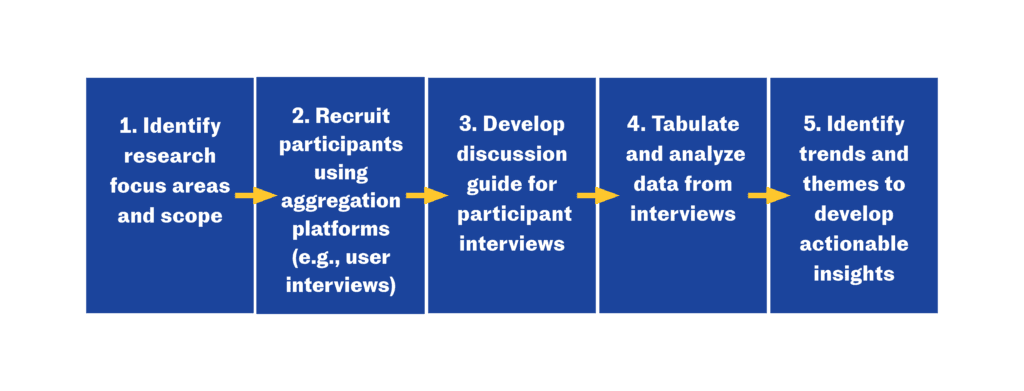Case study: Identifying pain points and expanding value proposition
Identifying pain points and tailoring value propositions is a continuous process for every successful startup. Even when product-market fit has been determined, it is crucial for a startup to continue validating, refining and expanding its core business model to better address its customer bases’ ever-changing needs.
To explore this further, we will look at the case of Pitstop. Pitstop is a predictive maintenance platform that delivers actionable insights for the transportation industry through a combination of AI, machine learning technology and cloud-based proprietary algorithms. The company has had success in both the Canadian and U.S. markets and serves logistics companies that operate in a variety of industries.
What was Pitstop’s key research need?
The team at Pitstop wanted to increase their conversion rate across their sales funnel and optimize their website to better suit their customers’ needs. The MaRS Market Intelligence (MI) team worked with Pitstop to:
- Uncover and validate key customer pain points
- Better understand Pitstop’s market to help build effective messaging
- Evaluate perceptions around product value
- Identify preferred product features
During the project, MaRS MI developed user personas to better segment desired project features, customer pain points and messaging around Pitstop’s value proposition.
Research process


Developing discussion guide and deriving insights
When developing a discussion guide, it is more effective to have a concise focus to drive your research. Avoid biased or leading questions when developing the guide. Often the most valuable insights and findings are outside the original hypothesis of the research and they may run counter to your original assumptions.
In this case, the MaRS MI team designed a discussion guide that explored participants’ roles, behaviours, strategies and preferences. The guide included a walkthrough of Pitstop’s website to get a better sense of the participants’ perceptions of the company’s messaging and website layout.
To validate hypotheses and assumptions on value proposition and pain points, include questions on the following subject areas:
| Who are they? (Customer/user personas) | Location, Role description, Organization/team structure, Preferred medium for ads, Workflow |
| What is their main goal? (Current strategy and pain points) | Importance/value of subject matter, Pain points, Current solutions/alternatives used, Perceived effectiveness of solutions, Areas of improvements for current solutions, Cost of pain points |
| Does your solution address their needs? (Product features and perception) | Desired product features, Response to marketing and educational material |
When going through marketing material, routinely ask the participants or users to explain what they understood of the feature or product. This will help identify gaps in understanding or messaging (and whether your participants were paying attention). Also ask them to evaluate their perceptions of the calls to action (CTAs) to understand whether they were being underused or incorporated too prematurely.
With all that said, while the guide is important to ensure consistency and conciseness, allow the conversation to flow organically. Some of the most surprising findings can be found in offshoots and digressions.
Data analysis
After conducting all the interviews, the MaRS MI team moved on to the data logging and analysis phase. Clustering and classification are essential steps in the process, as they allow shared patterns and themes to emerge from otherwise disparate data.
Themes identified through participant interviews for Pitstop
| Themes/Patterns | Sub-themes |
| Customer/user personas | Level of familiarity with predictive maintenance |
| In-office vs. in-field work percentage | |
| Preferred marketing channels | |
| Current fleet maintenance strategy | Relative importance of fleet maintenance |
| Most common pain points | |
| Common workflows | |
| Product features and perception | Most desired product features |
| Marketing material key feedback | |
| Level of understanding of Pitstop’s features and product |
Participants in Pitstop’s case were identified to fall under two main personas. One persona mentioned they either spend a significant portion of their time manually entering data or that certain manual data processes were a pain point. When targeting these users, Pitstop’s messaging and conveyed value proposition will now more clearly highlight how it addresses that issue.
While it is useful to ask users about their preferred product features, consumers often do not know what they want. In the example mentioned above, users did not mention process automation as a desired feature even though it would likely be well received. So, while these interviews may validate certain assumptions, they will frequently create new ones to be tested and iterated through.
Conclusion: Expanded value proposition and alleviated pain points
Research validated Pitstop’s current approach to addressing recurrent pain points within the logistics industry. It also identified unique pain points for their two distinct personas.
Primary research is a key tool in a startup’s arsenal to directly understanding their target audience. The process may lead to your product evolving and your value proposition expanding to address new needs within your core target customer base.
Pitstop’s feedback
“The MaRS team we worked with were phenomenal! They quickly understood what our challenges were and what stage we are at as a startup. Despite the complex offering, the results they shared are going to be very helpful to our company and overall strategy.” – Pitstop, Head of Marketing


